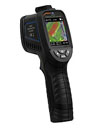PCE Instruments on how to detect the risk of mould using a thermal imager
A thermal imaging camera or thermal imager as provided by PCE Instruments can be used to locate mould-infested and mould-prone areas.

Moulds are widespread and their spores are therefore present almost everywhere in the air. The spores need sufficient moisture, suitable temperatures, nutrients and time to germinate and grow. Of these basic conditions for the development of mould damage, humidity is the condition that can be most easily influenced in normal building use. This can be illustrated by the everyday example of coffee grounds. If, after brewing coffee, the coffee grounds are left in the grounds container or filter bag for several days, mould will form under normal ambient conditions. To prevent this without changing the room temperature or creating clean-room conditions, the coffee grounds must be allowed to dry for a short time after they have been soaked. Even in the case of soaked components, drying should be ensured as soon as possible.
Of course, it is better to already prevent the entry of moisture into the building structure. Moisture penetration of building components can have various causes. Water can penetrate from the outside due to defective or blocked roof drains or defective connections, for example, of balconies or entrance roofings. From the inside, walls and ceilings can be soaked by splash water, defective water or heating pipes or by condensation. Condensation occurs when warm air cools down on cold surfaces and can therefore bind less water vapour. A thermal imager can be used to visualise areas with increased moisture as well as areas with lower temperatures that are at risk due to condensation. In principle, the thermal imager displays surfaces with increased heat radiation quickly and non-destructively. Damp materials conduct heat better than dry ones. Therefore, on the infrared image of a thermal imaging camera with sufficient resolution, not only geometric and material-related thermal bridges are visible in colour due to the temperature difference, but also damp spots in homogeneous wall structures. If areas are detected on the infrared image that clearly contrast in colour with the surroundings, it should be investigated whether other components or materials are installed in the wall cross-section at these points. It can often be concluded from the shape and position of these areas whether plaster rails, water, heating or electrical lines have been installed there or whether an earlier opening has been closed with other material. If this is not the case, it can be investigated more closely whether the wall or ceiling structure is already damp at this point or is at risk from condensation.
A thermal imager with an additional sensor for room temperature and air humidity is particularly suitable for assessing the risk of mould on building components. Such a thermal imaging camera can determine the dew point from the air humidity and room temperature. The dew point is the temperature above which condensation forms on the surface of the building component due to the cooling of the room air. A thermal imager with thermohygrometer function is, for example, the PCE-TC 25. It does not only show the thermal image as standard but also immediately displays the current air humidity (RH) and ambient temperature (AT) as well as the dew point (DEW) and wet bulb temperature (WBT) on the display. These values which are otherwise recorded with a separate thermo hygrometer allow conclusions about whether condensation and thus the risk of mould formation can be prevented by increasing the temperature or decreasing the humidity. The calculated dew point can be immediately compared to the lowest temperature value of the infrared image. When interpreting the thermal image and comparing temperatures, it should be noted that the temperatures in the thermal image may differ from the actual ones for various reasons. Superimposing the infrared image and the visual image helps to interpret the temperature representation.
Further information about thermal imagers from PCE Instruments can be found here: https://www.pce-instruments.com/english/measuring-instruments/test-meters/thermal-imager-kat_41330.htm
Ends
Article supplied by:
PCE Instruments UK
Email: info@pce-instruments.co.uk
Web: https://www.pce-instruments.com/english/pce-instruments-test-instruments-anbieter_2.htm
